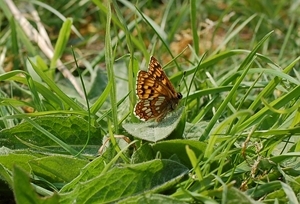The Duke of Burgundy (Hamearis lucina)
 The month of May is the time to go hunting “Dukes” – a small dark brown, pale orange and white mottled butterfly that is not much bigger than one of our blue butterflies. Dukes used to be widespread across the country as far north as southern Scotland, frequenting open coppiced woodland. They would have been well known to most woodsmen, as they soon moved into an area once the coppice began to re-grow.
The month of May is the time to go hunting “Dukes” – a small dark brown, pale orange and white mottled butterfly that is not much bigger than one of our blue butterflies. Dukes used to be widespread across the country as far north as southern Scotland, frequenting open coppiced woodland. They would have been well known to most woodsmen, as they soon moved into an area once the coppice began to re-grow.
With the almost complete lack of coppicing and general management within British woods nowadays, this little early summer butterfly has become one of the fastest declining species. It is now mainly concentrated in the south of England, along with a few isolated colonies in the Lake District and North York moors. What is more, because our woods have become so dark and shady due to the tree canopy closing over, Dukes have become a species that is now most commonly found outside of wooded areas. They are more often associated today with scrubby chalk or limestone grassland banks where dappled sunlight still exists.
As lovely as this little butterfly is, I have to say that it is a fussy little blighter, needing very specific requirements if it is to thrive. Let me explain! The Duke of Burgundy has a very short flying period, being seen from late April through to early June, with many individual adults literally only surviving a few days – just time to mate and for the female, to lay her eggs. She is very specific about her choice of food plant. Not only does she need either Cowslip or Primrose to lay her eggs on, but also the individual plant she chooses has to be in “dappled” sunlight and not growing in full sun. This is because the caterpillars need to feed on the green leaves through to the end of July and any plants growing in full sunshine will have wilted away by then, in all but the wettest of summers.
Bizarrely, many grassland areas suitable for Dukes have been “tidied up” by conservationists, who have cleared away the scrub (and therefore dappled shade) and introduced stock to graze down the grass sward. This is what a good many butterflies prefer but – you’ve guessed it – not Dukes! No, not only do they like areas that have their food plants growing in shady areas, but also, as they pupate and overwinter in tussocks, they don’t want the grass grazed! All of this has resulted in these fussy little butterflies often becoming restricted to grassland slopes with a northern, shaded aspect that has not had any recent management at all – especially from well-meaning conservationists!
The good news is that now that these specific requirements are understood, when small colonies of this delightful little butterfly are located, the correct management of limited scrub control can be introduced, with only light grazing in places. What is more, studies have shown that many females will often move around 250 metres during their short lives, with some dispersing several kilometres to establish new colonies in suitable sites up to 5km from known populations.
Two projects run by Butterfly Conservation in Kent and Hampshire, have also shown that when woods are once again coppiced, and the over-head canopy cleared to let in some light to the woodland floor, Dukes will respond big time, quickly returning to breed and follow the woodsmen’s progress once more.
A couple of years ago I stood with a group of farmers, woodsmen and keepers in one of these Kent woods that had had the “Duke” treatment. To my delight, the resident keeper on the estate told the gathered audience that this particular wood, although well positioned on top of a hill, had never held pheasants because it was far too cold. However, since this butterfly conservation lot had moved in and started to manage the place, it had now become his best drive on the whole place! Now that’s what I call progress!
Peter Thompson
Advisory
Read more from Peter Thompson at the Fresh from the Field blog.

Download Peter Thompson's essential 26-page book, featuring beautiful photography and detailed profiles of Britain's wildlife
Download FREE >